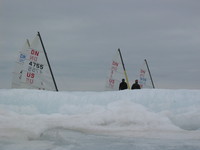Epoxy Tips
I just finished another boat and thought I'd share a couple of hints with inexperienced builders. I use West epoxy although there are other good ones out there. One of the first things I found out about epoxy is that it's a bear to sand. I have never found anything that plugs up sand paper faster then epoxy. I found an easy solution to this problem, use wet dry sandpaper,wet. You can use a piece of paper till it wears out. I coat most all of the interior surfaces with epoxy. To make the epoxy flow better and to save weight, I cut the mixed epoxy about 25% with acetone (make sure you wear a respirator when you do this). The last thing is to get a really nice finish I use a couple of coats of epoxy as a base coat for the varnish. The right way to do this is to use West's 207 hardner. It dries clear and is relatively easy to apply. Speaking of applying a finish, I roll it on with those neat yellow foam rollers then I smooth it out with a foam brush. I hope this helps.

I agree.
I used the same process when building my boat a couple years ago. Beyond that I found that another big challenge is sawdust management after doing the epoxy coat. My tip is to wait a couple days to do the epoxy coat from any woodwork that may have been done in the same workshop no matter how minor to get let the sawdust settle.
Copied directly from West systems website
This is directly from West Systems website-
There are epoxy-based products specifically designed to penetrate and reinforce rotted wood. These products, basically an epoxy thinned with solvents, do a good job of penetrating wood. But the solvents compromise the strength and moisture barrier properties of the epoxy. WEST SYSTEM epoxy can be thinned with solvents for greater penetration, but not without the same compromises in strength and moisture resistance. Acetone, toluene or MEK have been used to thin WEST SYSTEM epoxy and duplicate these penetrating epoxies with about the same effectiveness. If you chose to thin the epoxy, keep in mind that the strength and moisture protection of the epoxy are lost in proportion to the amount of solvent added.
There is a better solution to get good penetration without losing strength or moisture resistance. We recommend moderate heating of the repair area and the epoxy with a heat gun or heat lamp. The epoxy will have a lower viscosity and penetrate more deeply when it is warmed and contacts the warmed wood cavities and pores. Although the working life of the epoxy will be considerable shortened, slower hardeners (206, 207, 209) will have a longer working life and should penetrate more than 205 Hardener before they begin to gel. When the epoxy cures it will retain all of its strength and effectiveness as a moisture barrier, which we feel more than offsets any advantages gained by adding solvents to the epoxy.
Thinning Epoxy
I realize that the epoxy is somewhat compromised when thinned and would never consider doing this on an outside surface or a glue joint,but coating the inside could actually be done with varnish and thinned epoxy is a far better barriercoat.